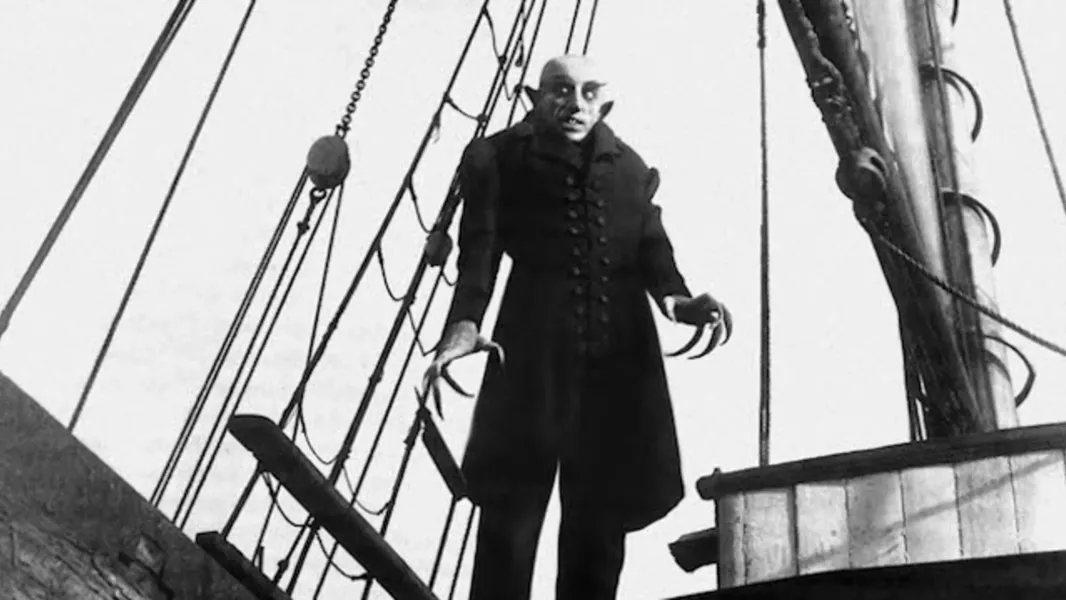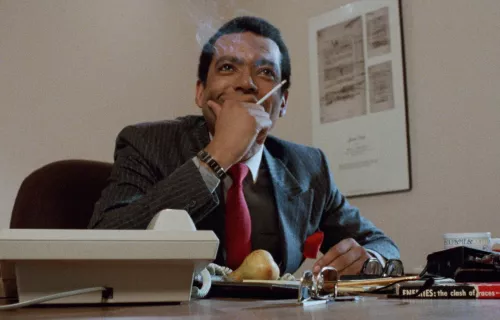
english below
NOSFERATU is een stille Duits expressionistische film, die een officieuze hervertelling is van Bram Stokers populaire roman DRACULA uit 1897. Het verhaal volgt Thomas Hutter (Gustav von Wangenheim), die naar Transsylvanië gestuurd wordt door zijn werkgever, de excentrieke vastgoedmakelaar Herr Knock (Alexander Granach). Daar heeft Thomas een afspraak met een potentiële nieuwe cliënt, Graaf Orlok (Max Schreck). De Graaf wil een huis kopen in Thomas’ thuisstad, Wisborg. Thomas laat zijn vrouw Ellen (Greta Schröder) achter en reist naar het kasteel van de Graaf in Transsylvanië om de verkoop te bespreken. Onderweg wordt Thomas geconfronteerd met vreemde zaken die rondom hem lijken te gebeuren en wanneer hij de crypte van de Graaf ontdekt, raakt hij ervan overtuigd dat Orlok een vampier is. Wanneer Graaf Orlok uiteindelijk wordt onthuld, volgt er een duidelijke verschuiving van een speelse naar een donkere en sinistere atmosfeer.
De film volgt het narratief van Stokers DRACULA, met Orlok die het titelpersonage vervangt. Door deze duidelijke narratieve ontlening, kregen regisseur F.W. Murnau en de studio Prana Film te maken met juridische problemen. NOSFERATU werd een van de eerste grote rechtszaken rond inbreuk op het auteursrecht in de filmgeschiedenis. De juridische strijd liep enkele jaren totdat een rechter in 1925 besliste dat alle fysieke en negatieve kopieën van NOSFERATU moesten vernietigd worden. Gelukkig kon NOSFERATU, net zoals in de film zelf, ontsnappen, omdat verschillende kopieën reeds de internationale grenzen hadden overgestoken. Ondanks het feit dat er geen originele print van de film bestaat, hebben filmconservatoren fragmenten van vroege kopieën samengevoegd tot een min of meer authentieke print. En sindsdien heeft NOSFERATU een onwrikbaar filmhistorisch nalatenschap uitgebouwd.
Filmcriticus Roger Ebert heeft niets dan lovende woorden over de film: “Here is the story of Dracula before it was buried alive in clichés, jokes, TV skits, cartoons and more than 30 other films. The film is in awe of its material. It seems to really believe in vampires. (…) NOSFERATU is more effective for being silent. In NOSFERATU (…) the characters are confronted with alarming images and denied the freedom to talk them away. There is no repartee in nightmares. Those things that live only at night do not need to talk, for their victims are asleep, waiting. NOSFERATU remains effective: It doesn't scare us, but it haunts us.”
Pianist Orfeas Demis zal live een eigen soundtrack brengen bij de film als afstudeerproject. Over zijn filmkeuze zegt hij: “It is one of my all-time favorites. I am a huge fan of gothic fiction and Murnau's version of this classic story is stunning, with such a unique atmosphere of horror. I will never forget scenes like the arrival of Hutter in the castle for the first time, or the beach with the crosses, almost dream-like scenes that had such a profound effect on me the first time I watched it. Musically, I will try and combine different influences that in the end are always present in my music. Places like the tavern scene in Transylvania certainly ask for a folky feeling while the scenes of "home" and Ellen will have a nostalgic tone. The Dies Irae will definitely appear somehow since after all, death is always present in the film. The expressionistic nature of the film allows for darkness and I think that the leitmotif of Orlok will definitely have a flavor of Bernard Herrmann because Hitchcock will always follow me!”
ENG
The film is silent with English intertitles
NOSFERATU is a silent German Expressionist movie that acts as an unofficial retelling of Bram Stoker's 1897 novel DRACULA. It follows Thomas Hutter (Gustav von Wangenheim), who is sent to Transylvania by his employer, eccentric estate agent Herr Knock (Alexander Granach), to visit a potential new client, Count Orlok (Max Schreck). The Count wishes to purchase a house across from Hutter’s own home in their small town of Wisborg. Hutter leaves behind his wife Ellen (Greta Schröder) and travels to the Count’s castle in Transylvania to discuss the sale. Hutter feels unsettled by strange events he encounters and after he sees the Count’s crypt, Hutter becomes convinced that he is dealing with a vampire. When Count Orlok is finally revealed, there is a clear shift and the whimsy from the opening is instantly replaced with a dark and sinister atmosphere.
The movie follows the narrative of DRACULA, with Orlok replacing the titular vampire, and even ran into legal difficulties, becoming one of the first major cases of film industry copyright infringement. The legal battle that followed dragged on for years until, in 1925, a German court ordered that all negatives and prints of NOSFERATU be destroyed. Luckily, much like in the film itself, NOSFERATU escaped, since it had already crossed international borders. While no single original print of Prana Film’s NOSFERATU exists, film preservationists have pieced together fragments from the earlier prints to arrive at a more or less authentic copy. And since then, NOSFERATU has grown an unshakeable legacy.
Film critic Roger Ebert has nothing but praise for the film: “Here is the story of Dracula before it was buried alive in clichés, jokes, TV skits, cartoons and more than 30 other films. The film is in awe of its material. It seems to really believe in vampires. (…) NOSFERATU is more effective for being silent. In NOSFERATU (…) the characters are confronted with alarming images and denied the freedom to talk them away. There is no repartee in nightmares. Those things that live only at night do not need to talk, for their victims are asleep, waiting. NOSFERATU remains effective: It doesn't scare us, but it haunts us.”
Pianist Orfeas Demis will perform his own soundtrack to the movie live as his graduation project. About his choice of film, he says: “It is one of my all-time favorites. I am a huge fan of gothic fiction and Murnau's version of this classic story is stunning, with such a unique atmosphere of horror. I will never forget scenes like the arrival of Hutter in the castle for the first time, or the beach with the crosses, almost dream-like scenes that had such a profound effect on me the first time I watched it. Musically, I will try and combine different influences that in the end are always present in my music. Places like the tavern scene in Transylvania certainly ask for a folky feeling while the scenes of "home" and Ellen will have a nostalgic tone. The Dies Irae will definitely appear somehow since after all, death is always present in the film. The expressionistic nature of the film allows for darkness and I think that the leitmotif of Orlok will definitely have a flavor of Bernard Herrmann because Hitchcock will always follow me!
About Orfeas Demis
Orfeas Demis was born in 1998, in Athens, Greece. In 2015, he obtained a Piano Diploma from the National Conservatory of Athens. Between 2014 and 2016 he followed the Music Course of the IB Diploma Programme under the instruction of pianist Panagiotis Markos. During these years he also joined masterclasses of pianist Vasileios Gioure, regarding improvisation, composition and jazz piano. He studied composition at the University of Music and Performing Arts Vienna (mdw) with Herbert Lauermann, Dietmar Schermann and Dominik Rodak. Since 2021 he studies classical Piano at the Royal Conservatory of Antwerp, in the class of Nikolaas Kende, completing the Bachelor in June 2024 and continuing with the Master's degree. He has performed in several significant venues of Greece, Austria and Belgium including de Bijloke in Ghent and Queen Elisabeth Hall as a harmonium player with Antwerp Symphony Orchestra.


